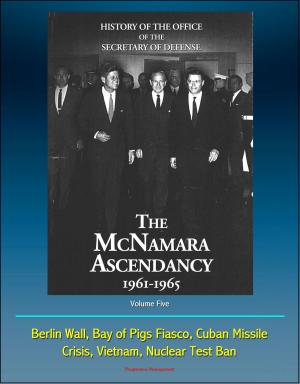The Evolution of the Combined Allied Headquarters in the North African Theater of Operations from 1942 to 1943: World War II Unity of Effort and Command, Eisenhower and Multinational Integration
Nonfiction, History, Military, United States, World War II| Author: | Progressive Management | ISBN: | 9781370759064 |
| Publisher: | Progressive Management | Publication: | February 25, 2017 |
| Imprint: | Smashwords Edition | Language: | English |
| Author: | Progressive Management |
| ISBN: | 9781370759064 |
| Publisher: | Progressive Management |
| Publication: | February 25, 2017 |
| Imprint: | Smashwords Edition |
| Language: | English |
This excellent report has been professionally converted for accurate flowing-text e-book format reproduction. Over the course of the North African campaign, General Eisenhower reorganized Allied Force Headquarters to establish unity of effort within his command. He used the principles of unity of command and multinational staff integration to bring all forces under his operational control, create land and air component commanders that exercised operational control over American, British, and French forces, and to get the right people in the right jobs regardless of nationality. Eisenhower saw unity of effort, and the principles employed to achieve it, as enablers to Allied Forces Headquarters' success in North Africa. When Eisenhower became Supreme Commander Allied Expeditionary Force, he employed the same principles to instill unity of effort within this new command. It is this author's assessment that today's multinational headquarters must employ these same principles.
Unity of Effort * Genesis of the Principle * Development of the Principle * Unity of Command * Genesis of the Principle * Development of the Principle * Multinational Integration * Genesis of the Principle * Development of the Principle * Conclusion * Unity of Command * Multinational Integration * Future Applicability * Bibliography
The clearest cause of the lack of unity of effort between Eisenhower, Anderson, and Fredendall was that Eisenhower chose not to name land and air component commanders who were able to command both American and British forces, that is, unified land and air component commanders. Eisenhower gave Anderson the responsibility and authority only to coordinate all land forces, meaning he was only the de facto land component commander. This condition required Eisenhower to ensure unity of effort between subordinate commanders if personality or battlefield induced stress, of which there was plenty during the North African campaign, prevented them from working well together. Eisenhower also proved a distracted air marshal, a role forced upon him as he had two air forces organized underneath him, the US 12th Air Force and the British Eastern Air Command. With no air component commander to coordinate action there was little effort pre-Kasserine to conduct an air campaign that established air superiority or interdicted Axis reinforcement and resupply efforts. Furthermore, the Spanish threat that occupied the Western Task Force, also occupied the Deputy Commander, Allied Force Headquarters, General Mark Clark, depriving the command of a leader with the requisite stature to coordinate operations in Eisenhower's absence.
This excellent report has been professionally converted for accurate flowing-text e-book format reproduction. Over the course of the North African campaign, General Eisenhower reorganized Allied Force Headquarters to establish unity of effort within his command. He used the principles of unity of command and multinational staff integration to bring all forces under his operational control, create land and air component commanders that exercised operational control over American, British, and French forces, and to get the right people in the right jobs regardless of nationality. Eisenhower saw unity of effort, and the principles employed to achieve it, as enablers to Allied Forces Headquarters' success in North Africa. When Eisenhower became Supreme Commander Allied Expeditionary Force, he employed the same principles to instill unity of effort within this new command. It is this author's assessment that today's multinational headquarters must employ these same principles.
Unity of Effort * Genesis of the Principle * Development of the Principle * Unity of Command * Genesis of the Principle * Development of the Principle * Multinational Integration * Genesis of the Principle * Development of the Principle * Conclusion * Unity of Command * Multinational Integration * Future Applicability * Bibliography
The clearest cause of the lack of unity of effort between Eisenhower, Anderson, and Fredendall was that Eisenhower chose not to name land and air component commanders who were able to command both American and British forces, that is, unified land and air component commanders. Eisenhower gave Anderson the responsibility and authority only to coordinate all land forces, meaning he was only the de facto land component commander. This condition required Eisenhower to ensure unity of effort between subordinate commanders if personality or battlefield induced stress, of which there was plenty during the North African campaign, prevented them from working well together. Eisenhower also proved a distracted air marshal, a role forced upon him as he had two air forces organized underneath him, the US 12th Air Force and the British Eastern Air Command. With no air component commander to coordinate action there was little effort pre-Kasserine to conduct an air campaign that established air superiority or interdicted Axis reinforcement and resupply efforts. Furthermore, the Spanish threat that occupied the Western Task Force, also occupied the Deputy Commander, Allied Force Headquarters, General Mark Clark, depriving the command of a leader with the requisite stature to coordinate operations in Eisenhower's absence.















